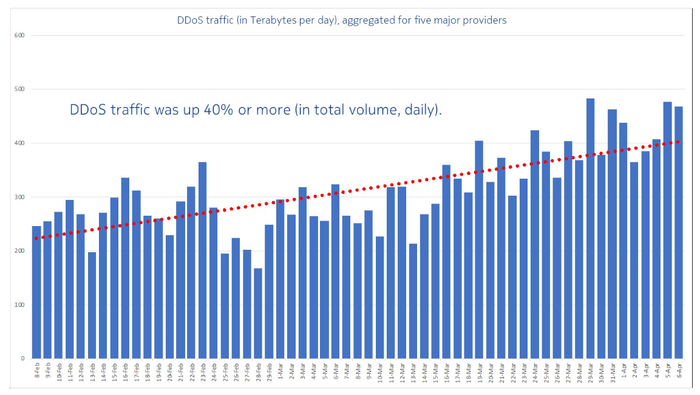Nokia: traffic surges are flattening but DDoS is on the up
Nokia has released its latest update on internet traffic during the coronavirus outbreak, and while networks seem to be standing up to the strain, Distributed Denial of Service (DDoS) traffic is on the up.
April 12, 2020

Nokia has released its latest update on internet traffic during the coronavirus outbreak, and while networks seem to be standing up to the strain, Distributed Denial of Service (DDoS) traffic is on the up.
As with every aspect of our lives, for all the good that some do there will always be others who try to take advantage of the situation. At a time where telcos are being presented with new challenges, the dark corners of the web are still home to those looking to capitalise on the tiniest of opportunities for nefarious means.
“We noticed a steady increase in the overall volume of DDoS traffic – with amounts exceeding the pre-pandemic levels by 40%,” said Craig Labovitz, CTO of Nokia Deepfield. “This increase may be related to the significant rise in gaming-related DDoS attacks; we continue to investigate this issue – so more to come on this topic.”
Distributed Denial of Service (DDoS) traffic is a malicious traffic aimed at rendering websites or online services inoperable. In short, it is the blunt tool of cybercriminals, one of the oldest tricks in the book but still very popular because of its effectiveness. By flooding one or more web servers with a disproportionately high-level of internet traffic, the aim is to reduce performance or take the service down.

One example has recently been discovered by Bitdefender researchers and has been named Dark_Nexus.
This new IOT botnet disguises traffic as innocuous browser-generated traffic to actively target IOT devices. There have been as many as 40 updates to the code between December 2019 and March 2020. It was potentially designed by greek.Helios, a known botnet author who sells DDoS services and botnet code.
On a slightly brighter note, Nokia has also confirmed traffic growth across Europe is flattening, likely due to a combination of peak video consumption, reaching practical maximum levels and the streaming services placing limitations on downloads. Many fears have already been calmed, but it is always worth reiterating; COVID-19 is highly unlikely to break the internet. Not unless it learns to twerk.
Internet traffic has been as much as 45% higher during the week following the introduction of self-isolation measures across Europe, and up to 20% higher on the weekend. Upstream traffic is still on the increase, but it does appear there is ample headroom for the telco networks to deal with the increased traffic.
About the Author
You May Also Like


.png?width=300&auto=webp&quality=80&disable=upscale)







.png?width=300&auto=webp&quality=80&disable=upscale)


_1.jpg?width=300&auto=webp&quality=80&disable=upscale)